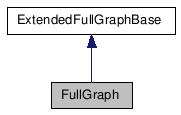FullGraph Class Reference
[Graph Structures]
Detailed Description
This is a simple and fast directed full graph implementation. It is completely static, so you can neither add nor delete either edges or nodes. Thus it conforms to the Graph concept and it also has an important extra feature that its maps are real reference maps.- See also:
- concepts::Graph.
#include <lemon/full_graph.h>
Inheritance diagram for FullGraph:

Public Member Functions | |
| FullGraph () | |
| Constructor. | |
| FullGraph (int n) | |
| Constructor. | |
| void | resize (int n) |
| Resize the graph. | |
| Node | operator() (int ix) const |
| Returns the node with the given index. | |
| int | index (const Node &node) const |
| Returns the index of the node. | |
| Edge | edge (const Node &u, const Node &v) const |
| int | nodeNum () const |
| Number of nodes. | |
| int | edgeNum () const |
| Number of edges. | |
Member Function Documentation
| void resize | ( | int | n | ) | [inline] |
Resize the graph. The function will fully destroy and build the graph. This cause that the maps of the graph will reallocated automatically and the previous values will be lost.
| Node operator() | ( | int | ix | ) | const [inline] |
| int index | ( | const Node & | node | ) | const [inline] |
| Edge edge | ( | const Node & | u, | |
| const Node & | v | |||
| ) | const [inline] |
Returns the edge connects the given nodes.
 1.5.9
1.5.9